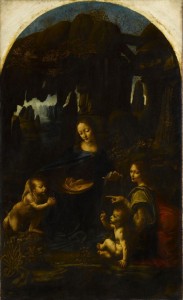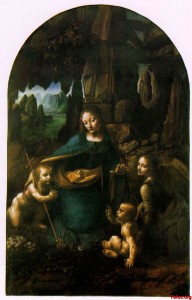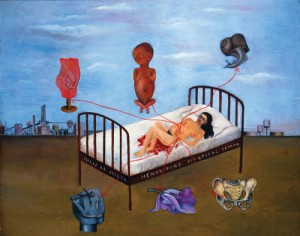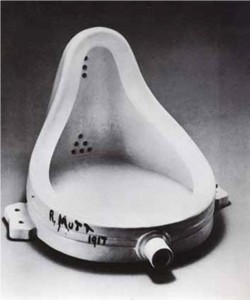Which is the “Real” Leonardo da Vinci?
There is a big brouhaha among two of the greatest museums in the world over what Leonardo da Vinci (painter of the “Mona Lisa” and “The Last Supper”) might or might not have painted five hundred years ago.
The National Gallery in London and the Louvre in Paris both claim an authentic Leonardo da Vinci painting…”Our Lady of the Rocks.” The Louvre says, “OUR ‘Lady of the Rocks’ is painted entirely by Leonardo.” Scholars all agree this is TRUE. However, the National Gallery in London shouts the house down with “Yes, but Leonardo did some work on OUR ‘Lady of the Rocks,’ although painted 25 years later, so therefore it TOO is a Leonardo.” Some scholars disagree and are still debating whether Leonardo may or may not have added a few brush strokes to the National Gallery’s painting.
Decide for yourself which is the “real” painting.
Hint:
1. Leonardo’s genius was portraying real human emotions on his subjects faces.
2. Leonardo believed painting was a form of science and he invented a technique of blurring edges (sfumato) to produce mellowed colors and leave something to the imagination. No sharp edges.
Take a look at the two paintings above. Which do you think is the “real” Leonardo?
Answer: ervuoL ehT………………………….(the first painting)
Passion…Heartbreak…Art
Frida Kahlo, born in Mexico, 1907, was severely injured in a streetcar accident nearly severing her spine. Confined to her bed for many months, she began painting while lying on her back. Chronic pain stayed with her throughout her life.
Frida, 22, petite and beautiful, married Mexico’s most well known artist, Diego Rivera, 42, voluminous and reportedly resembling a frog . Passionately in love, they lived in a bright blue house and joined the Mexican Communist party.
Shortly after the marriage, Diego, although deeply in love with Frida, but chronically unfaithful, began affairs with other women. Frida suffered two miscarriages and produced her graphic/symbolic masterpiece paintings of emotional and physical pain… paintings that exalt the ability of women to endure truth, reality, cruelty and suffering. They are heartbreaking.
Frida’s fame grew, culminating in the purchase in 1939 of one of her portraits by the Louvre, Paris. Frida was the first Mexican woman artist to be represented in a major European institution.
Frida died at 47 in 1954.
Diego Rivera…”This day is the most tragic day of my life. I have lost my beloved Frida forever. Too late now, I realize that the most wonderful part of my life has been my love for Frida.”
Frida Kahlo…”I suffered two grave accidents in my life. One was when a streetcar knocked me down. The other was Diego.”
Violence is on the Decline!
Violence is on the Decline!
“Believe it or not, the world of the past was much more violent than our world today. Violence has been in decline for thousands of years and today we may be living in the most PEACEFUL era in the existence of our species.” Dr. Steven Pinker, cognitive neuroscientist and Professor of Psychology, Harvard College, and twice nominee for the Pulitzer Prize, scientifically demonstrates through data sets and graphs that this is a fact.
One of the most treasured paintings in the Prado Museum in Madrid, Spain is the artist de Goya’s terribly beautiful painting, “The Third of May.” The canvas shows the cruelty of Napoleon’s armies during the occupation of Spain in 1808. Each figure in the painting presents a different emotion when facing death.
We are haunted daily by appalling images of violence and genocide in the media. Is violence really declining in our world?
Listen to Dr. Pinker prove his point. Click here if unable to view the video.
Is This Art?
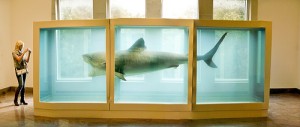
"The Physical Impossibility of Death in the Mind of Someone Living" (shark preserved in formaldehyde)
Damien Hirst, 1991
Is This Art?
Marcel Duchamp, one of the most important artists of the 20th century, stunned the art world in 1917 by displaying an upended urinal as a sculpture. This was considered a landmark event, which began the movement of using an ordinary object and elevating it to a work of art.
Damien Hirst, born in 1965, is Britain’s richest living artist. He is famous for his works of art in which dead animals are preserved in formaldehyde. The above pictured dead shark suspended in formaldehyde sold in 1991 for a reported $8 million dollars.
Does taking an object out of context and displaying it elsewhere make us see it differently? Are the curving lines and the smooth porcelain of the urinal beautiful? But what can we say about the shark? Is this art? What do you think?
Picasso, you rascal, you!
Picasso:
“I remember one day while I was painting Guernica in the big studio in the Rue des Grands-Augustins, Dora Maar was with me. Marie-Therese dropped in and when she found Dora there, she grew angry and said to her ‘I have a child by this man. It’s my place to be here with him. You can leave right now.’
Dora said, ‘I have as much reason as you have to be here. I haven’t borne him a child but I don’t see what difference that makes.’
I kept on painting and they kept on arguing.
Finally, Marie-Therese turned to me and said, ‘Make up your mind. Which one of us goes?’
It was a hard decision to make. I liked them both, for different reasons: Marie-Therese because she was sweet and gentle, and did whatever I wanted her to; Dora because she was intelligent. I decided I had no interest in making a decision. I was satisfied with things as they were. I told them they’d have to fight it out themselves. So they began to wrestle. It’s one of my choicest memories.”
Hall, D. & Wykes, P. (1990). Anecdotes of Modern Art. As Picasso told Francoise Gilot.

